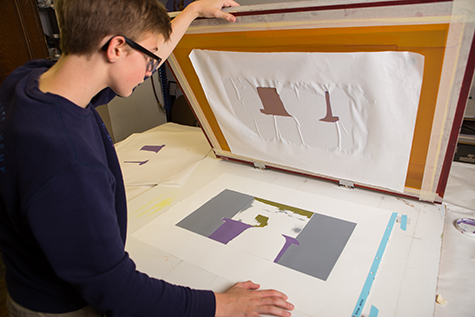The Important Guide to Recognizing Screen Printing and Its Versatile Makes use of
Screen printing has an abundant history that dates back to ancient times, progressing right into an advanced technique made use of across various sectors today. This guide checks out the complexities of the screen printing procedure, detailing its applications in advertising, style, and home décor - 10:9 Design LLC Company. Understanding these principles can open up imaginative potential for both industrial and artistic jobs. The adhering to areas will reveal necessary pointers and techniques to enhance one's screen printing ventures
The History of Screen Printing
Although screen printing has origins that trace back centuries, its development mirrors the technical and creative improvements of numerous societies. Stemming in old China, the technique was originally made use of for embellishing textiles and later spread to Japan, where it became integral to Ukiyo-e woodblock printing. The approach moved to Europe in the 18th century, where it obtained popularity amongst craftsmens and commercial printers. The development of photo solution in the 20th century changed screen printing, enabling more complex layouts and better efficiency. Musicians like Andy Warhol additionally drove its popularity, utilizing the tool to create famous works that blended commercialism and great art. By the late 20th century, screen printing had developed itself as a functional method, utilized in style, advertising, and fine art. Today, it proceeds to develop, integrating electronic innovation and increasing its applications throughout numerous industries.
The Screen Printing Refine Explained
Screen printing transforms imaginative visions right into tangible designs via a collection of accurate steps. At first, a photo is created and then moved onto a screen, normally constructed from great mesh fabric extended over a framework. A light-sensitive solution is put on the screen, which is revealed to light, hardening in areas not covered by the image. After washing out the unhardened solution, a pattern is created.
Next, the screen is positioned over the substratum, whether it be fabric, paper, or one more product. Ink is then pressed via the open locations of the stencil utilizing a squeegee, transferring the design onto the substratum below. This procedure can be duplicated for multiple shades, needing different displays for each and every tone. The published item is treated utilizing warm to assure the ink adheres correctly, resulting in a long lasting, dynamic layout ready for usage.
Kinds Of Screen Printing Techniques

Additionally, specialized methods, such as discharge screen printing, eliminate dye from the fabric to create softer prints, while foil screen printing uses metal aluminum foil to accomplish a glossy surface (10:9 Design Screen Printing). Each strategy supplies unique attributes, accommodating numerous innovative needs and production scales, inevitably expanding the possibilities within the check out here screen printing domain name
Applications of Screen Printing in Different Industries

Additionally, the signage and advertising and marketing markets make use of screen printing for producing eye-catching displays and banners. This method enables bold shades and detailed designs that record focus. In electronics, screen printing is used for using conductive inks to motherboard, important for element links. Moreover, the home decoration sector embraces screen printing to generate distinct designs on fabrics and wall art. Overall, screen printing offers as a crucial tool throughout diverse areas, improving items with individualized and visually attractive graphics.
Tips for Successful Screen Printing Projects
While carrying out a screen printing task, mindful focus to detail can considerably improve the last end result. First, choosing high-grade materials is vital; this consists of the screen, inks, and substrates. Utilizing suitable mesh matters can impact ink deposition and information resolution. Prep work is similarly crucial; comprehensive cleaning of displays and appropriate direct exposure times ensure crisp prints.
Next off, accurate enrollment is critical for multi-color prints. Utilizing placement devices can assist attain precise layering. In addition, screening prints on scrap products before production helps recognize prospective concerns without losing sources.

Regularly Asked Concerns
What Products Are Best for Screen Printing on Fabric?
Cotton and polyester blends are optimal for screen he said printing on fabric due to their longevity and ink absorption. Additionally, specialty fabrics like silk or canvas can produce distinct structures and surfaces, boosting the general style high quality.
Just how Do I Tidy and Maintain Screen Printing Devices?
To keep and clean screen printing devices, one need to routinely clean displays with appropriate solvents, check squeegees for wear, lube relocating parts, and store all products in a dry, dust-free setting to prolong their life-span.
What Are the Environmental Influences of Screen Printing?
Screen printing can have significant environmental effects, consisting of chemical waste from inks and solvents, water usage throughout cleansing procedures, and power intake. Green materials and sustainable techniques are vital for lessening these negative effects.
Can Screen Printing Be Done at Home Effectively?
Screen printing can be properly done at home with the appropriate materials and techniques. Enthusiasts can create top quality prints, though success relies on their ability level, devices, and understanding of the procedure included.
What Are the Expenses Connected With Beginning a Display Printing Organization?

Starting a screen printing company entails costs for tools, materials, and work space. Initial expenses commonly vary from a couple of hundred to a number of thousand dollars, depending upon the scale, high quality of machinery, and preferred manufacturing ability.
Screen printing has a rich background that dates back to ancient times, developing right into a sophisticated method made use of across different industries today. One more strategy, rotating screen printing, employs round displays, facilitating continuous printing on textile rolls, therefore improving performance for massive productions. Additionally, specialty methods, such as discharge screen printing, remove dye from the material to develop softer prints, while aluminum foil screen printing uses metallic foil to attain a shiny surface. In the style sector, screen printing is extensively utilized to produce dynamic styles on clothing, allowing brands to showcase their unique styles. Cotton and polyester blends are ideal for screen printing on fabric due to their resilience and ink absorption.